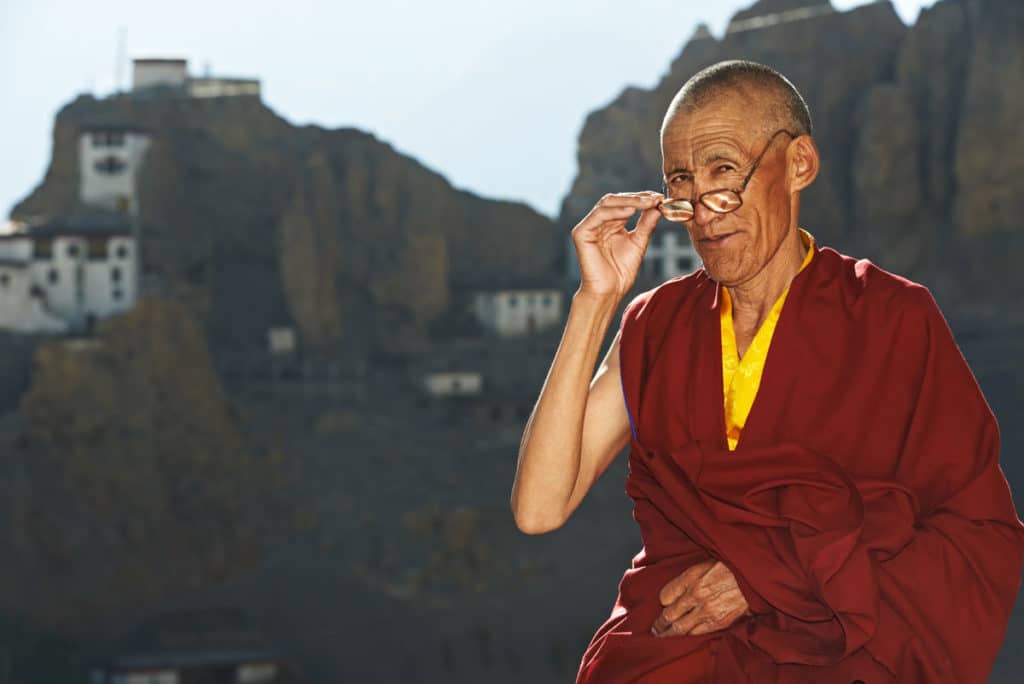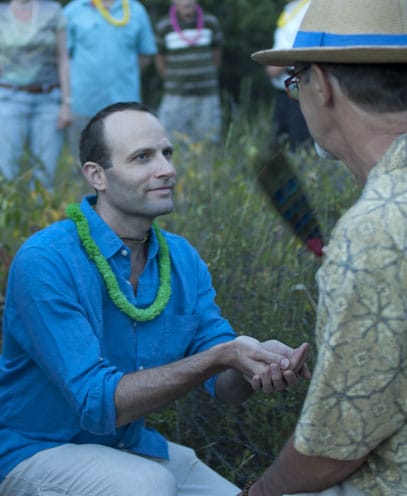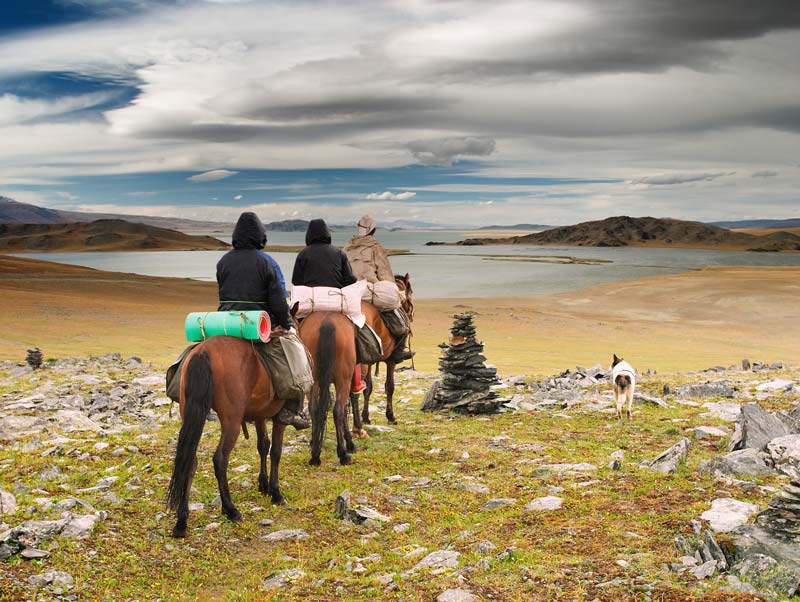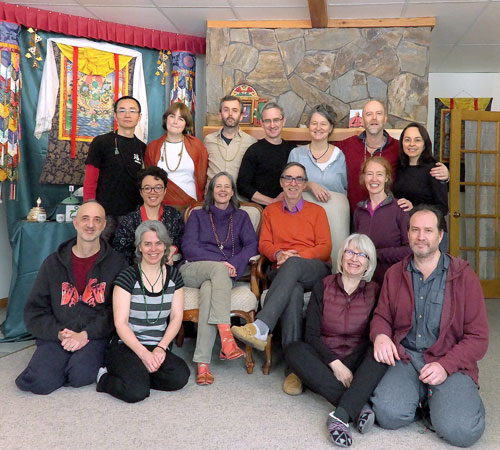
Spiritual Awakening Today: Bridging Old and New
How might one attain to spiritual awakening in the modern world, in these complex times? In this article we look back at the two main historical models for spiritual training, and propose a contemporary approach for today.
The spiritual seekers of old retired to the forest, the desert or a cave to seek a kind of freedom they couldn’t find in their day-to-day lives. They lived in isolation, meditating or praying in a state of question and investigation, looking for greater meaning or purpose beyond the daily routine. They worked with their teachers in a close personal relationship that could last for years.
And they found something: Spiritual Awakening. What they discovered – in spite of some later misinterpretations by people who hadn’t done the same inner and outer work – was a message that has fed and sustained humanity ever since. All these beings clearly stated that we could do the same thing ourselves: We could all experience spiritual awakening.
But, for most of us, “the spirit is ready, but the body is weak.” (Matthew 26:41, Aramaic Bible in Plain English) This means that we are attached to our creature comforts, and spiritual awakening remains elusive.
The Great Prize: Spiritual Awakening
As human beings, we desire the best result for the least effort. And though this is not only smart but also efficient, nevertheless, the ‘great prize’ is typically missed because we don’t recognize what the best actually is. The best is called ‘Awakening’.
Spiritual awakening is the opposite of ‘asleep’ and unfortunately that is what our habitual pursuit of comfort does – it puts us to sleep.
It takes effort to wake up but once we are awake, life becomes so much better and so much easier. It is the most economical, sustainable, ethical, fruitful and joyous state available to human beings. It takes far less effort than all the other pursuits the self-referencing ego identity chases after because we are no longer attached to the struggle, the pain, of chasing them.
When we remove ‘being subject to struggle,’ the texts and realized beings tell us we are left with a few special qualities. Namely, a loving disposition, a willingness and drive to be compassionate, joyousness in the successes and discoveries of ourselves and others and a great sense of equanimity (not to be confused with hedonic indifference).
The How of Spiritual Awakening, Historically
The Big Question becomes: how do we realize this ongoing state of bliss and clarity called ‘Spiritual Awakening’, ‘Liberation’ and ‘Transcendentalizing’ (to name a few)? Like any great career it takes training. Some have claimed it takes 10,000 hours to get really good at anything. Natural ability may give you an edge but training is what ‘brings home the gold’. Traditionally there have been two main training methods for spiritual awakening aspirants: the yogic model and the monastic model.
The Yogic Model of Spiritual Awakening
In the yogic model one retires from the world and studies and meditates in semi-isolation with one’s teacher or guide. An adept may undergo years of training before their dedication to the path will clearly reveal spiritual awakening. The teacher is necessary because addiction to one’s own culturally biased viewpoint blinds us to the suffering this entails. The nature of a blind spot is that it is blind!

history of spiritual awakening
The pernicious nature of our ego habits causes us to fight and resist when these habits are interrupted, even though it is these very habits that demoralize us. Wrestling our attention away so that we can focus on the clear, spacious nature of our ‘mind’ means to surrender, to step over, our limited self-referencing agendas that are, at best, near misses to satisfaction.
Initially, the ego sees the teacher as just another ego. Thus the challenge is to see the teacher as a manifestation of the radiant, spacious mind and not his or her personality. After all, every manifestation in form is ‘imperfect’ even if the underlying realization of spiritual awakening is pristine.
For those who want to train without a teacher, there is do-it-yourself Dharma. Although it has some uses and is very popular these days, it is doomed to limited success because the final ‘power’ (understanding) is still held by the self, the ego, which by definition is asleep. All the ancient wisdom masters have always agreed on this point.
The yogic model is unstructured and free in the sense that it is not institutionalized, but life with a teacher in a yogic situation can be every bit as demanding as monastery. The yogic model is challenging because there is no escape. It is face-to-face day in and day out and there isn’t a lot to do except practice. It is also a rough and ready lifestyle, so livelihood and relationships are put on the back burner.
Buddha and Christ are examples of the yogic lifestyle, and they also had teachers. What makes them unique and memorable is their re-interpretation or re-presentation of timeless teachings of spiritual awakening.
The Monastic Model of Spiritual Awakening
The other model is the monastic style of spiritual awakening. In this model one lives in community. There is still the teacher, the abbot, the Lama or the Sensei, but one must also learn to live and work together with others.
The added complication of many egos creates not only more struggles but also greater potential for creativity and connection. While in a yogic situation the training is focused on practicing and serving the teacher, in a monastery it also involves communal living and thus requires daily interactions through group activities.

spiritual enlightenment
Every tradition of spiritual awakening has, in some form or other, modeled these two systems (Yogic and Monastic). Teachings are received from the Lama or abbot or their appointee and are then applied while going about one’s daily activities.
Laypeople whose lives are driven by the day-to-day cares of the largely self focused pursuit of happiness (not realizing the ‘objects’ they pursue are mere shadows of what they seek) are left to receive teachings if they desire but are considered not yet ready for formal training. They may occasionally do retreats within these systems, but generally, live their life in the world of physical, emotional and mental objects and try as best as they can to apply the teachings to their daily life.
As far as the vast majority of us are concerned this leaves most of us behind. This does not have to be so.
Spiritual Awakening Today
What is generally missing for a layperson is a commitment and dedication to the training process that goes on day in and day out in the yogic & monastic models. In the past the yogic and monastic models entailed removing oneself from the world. They required the yogi to live for the teacher and the community (for spiritual awakening) rather than for themselves.

meditation spiritual awakening
These days it seems spiritual awakening is not a large enough draw for beings to dedicate themselves to the monastic or yogic systems. People don’t like authority and feel independent. They don’t have to answer to anyone (they may feel they must answer to bosses, wives and husbands, but these people never really challenge us at the core of our identity).
People do their ‘own thing’ and as such, if they glimpse spiritual awakening at all, for example in a moment of ‘oneness’ while in nature or on psychedelic drugs, it is often fleeting and probably not very sustainable.
Problems such as over-population, climate change, environmental degradation, resource depletion, terrorism, the threat of nuclear destruction and the globalization of the economy (which seems, at this point, to mainly benefit multinationals) take center stage in people’s minds. They trigger fear, the survival instinct, and thus keep people locked in the struggle of the ego.
Today, in North America, there is a culture of ego-clinging: the most common living arrangement in the USA is single people living alone. Marriage is often seen as temporary and perhaps not even desirable, we switch careers throughout life and move from town to town never being able to ‘catch’ happiness, we seek community but seem to have a hard time living in one, and social media is a substitute for social discourse. It is precisely now that there needs to be a reviving and retooling of these old yogic and monastic models. This implies a new and changing identity. We are becoming avatars to ourselves.
What’s Next for Spiritual Awakening, Forward Ho!

Meditation Spiritual Awakening
The realizations and understandings of spiritual awakening remain the same in essence although their forms appear different in various traditions or change over the course of history. For example in Buddhism, Theravada morphed into Mahayana, which morphed into Vajrayana where it is today. Some people have coined the term Novayana—the new vehicle.
When Buddhism moved from India into the Himalayas and Japan it adopted much of the shamanistic native cultures there and integrated them with the Buddha’s realizations. Christianity did the same thing. The expressions changed while the heart and wisdom remained.
The Planetary Vehicle – A Modern Integration of Monastic and Yogic
We propose a new form of the spiritual community that we call The Planetary Vehicle. In this model, the yogic and monastic traditions are integrated with modern sensibilities and lifestyles.

Spiritual Enlightenment
We divide the teaching into three streams;
- the listening stream,
- the training stream, and
- the hybrid stream.
In the listening stream a student studies, attends classes and does retreats. They are encouraged to share this with others that are interested in their daily lives. In the training stream the student also works with a trainer (The Buddha was called a trainer).
Training enables a person to work with others more closely and with greater depth, maturing that person’s relationships and themselves.
Training to Study Our Responses to Manipulation & Control
All relationships are on about manipulation and control. The key point is what do we manipulate and control for. In the listening stream this is not addressed directly whereas in the training stream we study our responses to manipulation and control with our trainer. We learn how much of our ego satisfaction is hidden in habits of manipulation and control. We also learn that it is these very habits that are interfering with transcendent satisfaction and spiritual awakening.
The hybrid stream is in the middle, in that there is more training then the listening stream but less than in the training stream.
Manifesting the Listening, Training & Hybrid Streams
There are various ways for these streams for spiritual awakening to manifest. One is at our meditation center, Clear Sky in the Canadian Rockies. Here we do more in depth work and ‘in person training’. Having a longer period of time to work with individuals allows us to develop in more detail the principles and practices that lead to unfoldment.
The second is where students live in communities within larger urban centers. This facilitates ‘journeymen’ trainers, people who have had a fair bit of training already, and who are now ready to begin training others. By living together with other practitioners there is a basis for mutual support and also for mutual training to keep the practice alive to the day-to-day diversions and necessities like earning a living and being in relationships.
The third manifestation of the training is virtual. Our website (planetdharma.com) offers webinars, blogs, podcasts, videos, newsletters and course descriptions as well as meetings with students via Skype. This allows students to stay in contact with us at a distance throughout the year as well as providing an entry point for new people who may be interested.
Continuity and Consistency: Bridging Retreat and Daily Life
It is our experience that the difficulty with integrating the spiritual life in our times is with continuity and consistency. When we leave the retreat environment and return to daily life, old habits tend to take over. We tend to lose the clarity and focused bliss that we contacted in retreat or during a course at Clear Sky. When we are in the ‘real world’ and inundated with sensations and appetites, the habitual mind of the general population becomes contagious and we tend to forget to stay mindful under these conditions.
By having an online presence with Planet Dharma, by having satellite centers where people can work and live together and provide public teaching, and by regular and consistent interaction with trainers working in the world, we can have a successful form of spiritual practice.

Continuity and Consistency
If we bring focus and consistency to our lay spiritual life, and do not drift off into distractions and entertainment, then we can have the same results as yogic or monastic training. The old monastic models of celibacy and a narrow range of interests can be adapted to our modern times where careers, relationships and exploration and discovery can enhance our spiritual lives through creativity and the richness of others. Since 2007, the cities are where most people live. They are rich in potential and possibilities with such activities as museums, the arts, intercultural exchange and access to greater diversity.
While visiting centers, such as Clear Sky, remain a necessity for deeper work, conjoining the benefits of both worlds and using the three streams provides a methodology and a technology that far more people can use to realize the awakened mind.
